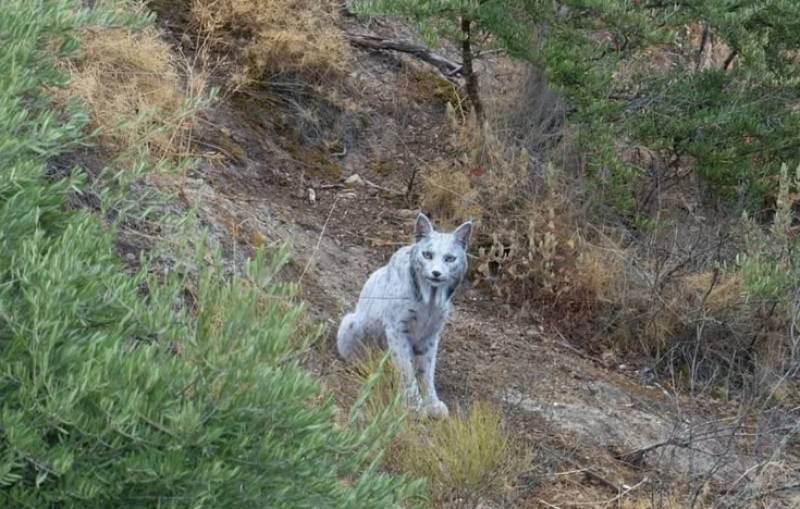
To be listed on the haciendadelalamo TODAY MAP please call +34 968 018 268.
article_detail
Date Published: 30/10/2025
Incredibly rare white Iberian lynx photographed in Andalucia
The striking pale lynx has captivated Spain, though experts say the colour change is temporary

When nature photographer Ángel Hidalgo captured images of a snow-white Iberian lynx in Jaén province on October 22, the photos spread like wildfire across social media. Here was something nobody had seen before, a ghostly pale lynx with piercing eyes that seemed to glow against the landscape.
Many immediately called it ‘leucistic’, suggesting a rare genetic phenomenon had created what could be the only specimen of its kind in the world.
The reality, it turns out, is rather different, although no less stunning.
The Life Lynx Connect Project has since stepped in to set the record straight about the reports circulating in recent days. Javier Salcedo, the regional coordinator of the Iberian Lynx Recovery Plan in Andalucia, confirmed that while the animal and photograph are very real, the explanation isn't what people initially thought.
"The animal exists, the photograph is real, but many things are being said that don't make sense," Mr Salcedo stated.
He explained that the lynx in question "had normal colouration and in a short time turned white," a change that is not genetic in origin.
This isn't even the first time it's happened, according to the expert.
"We already had another female, possibly related to this specimen, that also turned white and then recovered her normal colouration," he said.
You might also like: Iberian Lynx makes hopeful return to Cordoba mountains after 50 years
The experts attribute this dramatic colour change to stress or other external factors that can temporarily alter the synthesis of melanin, the pigment responsible for coat colour. Think of it like when a person loses hair due to stress and then it grows back. It's environmental rather than genetic, which means it's not leucism at all, despite the initial excitement.
Mr Salcedo emphasised that the phenomenon is completely reversible and poses no risk to the animal's health.
"Don't worry, the lynx is perfectly fine. Its behaviour is completely normal. It simply now has white fur, which makes it very striking and generates a lot of interest."
The big cat was spotted in Jaén province, though for obvious reasons of security and species protection, the Lynx Project isn't revealing the exact location. The coordinator stressed the importance of verifying scientific information before spreading news that could cause confusion.
"This is not a case of leucism, nor an exceptional genetic finding, but rather a temporary change in skin colour caused by external factors," Mr Salcedo concluded.
The story behind the images
The photographer behind the viral images is Ángel Hidalgo, a 29 year old from Jaén who's passionate about tracking and camera trapping. This technique involves installing hidden cameras at strategic points in natural habitats to record the passage of wildlife, and it requires enormous patience and dedication.
"I've been setting up cameras for many years, with many failed attempts and countless hours of work, but this time nature has given me something unique," he said, clearly moved by the experience.
Mr Hidalgo explained that the discovery began months ago when he started exploring a new area of the province.
"In a new place where I started exploring a few months ago, while reviewing one of my cameras, I saw something I couldn't believe. From then on, I began to dedicate all the time I had available to it. I had to see this wonder with my own eyes."
After weeks of waiting and several unsuccessful attempts, the young photographer finally achieved his goal.
"One bad morning, after it had rained during the night, at dawn, I was walking as I had done so many times before, when suddenly, in the distance, I saw a white shape that seemed to radiate its own light."
"When I first saw this Iberian lynx with its snow-white winter coat and those piercing eyes, I was speechless. I felt incredibly fortunate to witness this moment, to see it in its natural habitat," Mr Hidalgo recalled, still amazed by the experience.
"This encounter is an unforgettable memory and made me reflect on the importance of conservation. I hope it inspires others to appreciate and protect the natural beauty of the world around us."
Images: Ángel Hidalgo
Loading
See more news about animals in Spain:
OR
Sign up for the Spanish News Today Editors Roundup Weekly Bulletin to get a comprehensive email with all the week’s news for Spain, Murcia, Alicante and Andalucía.
Get a sneak peek – here are a few of our recent Subscription Bulletins:
Discount Special Offer subscription:
36.95€ for 48 Editor’s Weekly News Roundup bulletins!
Please CLICK THE BUTTON to subscribe.
Contact Murcia Today: Editorial 000 000 000 /
Office 000 000 000





















